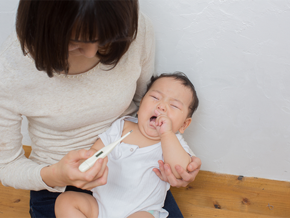
As a parent, you quickly become familiar with every detail of your little one, including the contents of their diapers! Monitoring baby poop is one way to check their health and digestion. Knowing what’s typical in baby stool can give you peace of mind, while recognizing potential warning signs helps you seek timely care.
From newborn poop color changes in the first few days to stool shifts when starting solids, this guide can help you decode what you're seeing. Explore what's typical and when you might need to consult your pediatrician.
Healthy Colors and Consistency
From mustard yellow to earthy brown, normal baby poop comes in many shades and forms.
The look and feel of your baby's stool offer clues about their digestion, especially considering their feeding method.
Black or dark green poop (first days)
In the first day or two, expect newborn poop color to be dark greenish-black and very sticky, almost like tar. This is meconium, which is made of substances ingested in the womb and is completely normal.
Yellow or green poop (milk feedings)
Mustard yellow, often loose and seedy, is typical for breastfed babies. It's often loose, soft, or even runny, sometimes with small, seed-like particles (undigested milk fat globules—totally fine!). It has a mild, slightly sweet smell. Seeing healthy, normal breastfed baby poop like this is a good sign.
Expect to see light to dark green baby poop for both breastfed and formula-fed babies (depending on the formula type).
Brown, tan, orange, and other colors
Formula-fed baby poop often looks tan or brown to yellowish green with a thicker, paste-like consistency similar to peanut butter. It also has a more pungent smell than breastfed baby stool.
Once you introduce solid food, get ready for variety! Stool color often reflects what babies ate (hello, orange stool after carrots!). The consistency will become firmer and more variable, moving closer to adult stool, though usually softer. You might also see undigested food pieces. If you’re unsure, infant stool charts can help you understand stool textures.
Frequency and Patterns
Understanding typical pooping schedules can help you recognize your baby's unique pattern and know what to expect.
Newborns
Breastfed babies might poop after every feeding, sometimes five to six times a day or even more! Formula-fed newborns might poop slightly less often, maybe one to four times a day.
Older babies
Research shows frequency tends to peak around 3 weeks of age before gradually decreasing. As they grow older, some breastfed babies over a month old might even go several days or occasionally up to a week without pooping! This can be normal if they appear happy, are feeding well, are gaining weight appropriately, and the poop is soft when it eventually arrives. Formula-fed infants tend to poop at least once a day or every other day.
Toddlers (1–3 years)
Frequency might range from three times a day to once every two or three days.
The key is consistency for your baby. If you notice a sudden change from their usual routine (pooping much more or much less often), especially with other signs, it's best to check with your doctor.
Baby Poop Color: Red Flags to Watch For

While most baby poop variations are normal, certain colors or textures need prompt medical attention.
Wondering when to be concerned about baby poop? Some signs point to a possible health problem and are good reasons to check in with your pediatrician:
Red
Bright red streaks could indicate blood, often from small tears (fissures) caused by straining with constipation, or potentially a milk allergy. Larger amounts of blood require medical attention. (Note: certain foods like beetroot and watermelon can sometimes cause harmless red discoloration.)
Black
While newborn meconium is dark, it typically passes within the first 24 to 48 hours. So, black stools after this initial period (that aren't dark green from formula or iron) could signify digested blood from higher up in the digestive tract. Always check with your doctor.
White, chalky, or pale gray
These colors can suggest a liver or gallbladder problem, meaning bile isn't reaching the stool properly. This requires urgent medical assessment.
Very watery stools (diarrhea)
This is more frequent and much looser or liquid than usual, possibly soaking through diapers. Watery baby poop or newborn watery poop, especially if accompanied by fever, vomiting, or signs of dehydration (fewer wet diapers, sunken eyes, lethargy), needs medical attention. This could be baby diarrhea.
Hard, pellet-like stools (constipation)
These tend to be small, firm balls that are difficult or painful to pass. Your baby might strain excessively, cry, and seem uncomfortable. While occasional straining is normal, persistent difficulty passing hard stools is constipation.
Mucus in baby poop
Occasionally, seeing slimy streaks can be normal, perhaps during teething or a cold. However, large amounts of mucus, especially if persistent or combined with other symptoms like blood or diarrhea, could signal an infection, allergy, or other irritation.
Frothy or greasy stools
Consistently frothy stools might mean an overload of foremilk (in breastfeeding). Very pale, greasy, and foul-smelling poop may indicate malabsorption.
Undigested milk in baby stool
Seeing tiny white seed-like bits is normal in breastfed babies. But if you consistently see larger curds or significant amounts of undigested milk in baby stool, you might want to consult your pediatrician about digestion.
Never hesitate to contact your pediatrician if you're concerned about your baby’s bowel movements, especially if changes come with fever, vomiting, poor feeding, lethargy, or poor weight gain.
FAQs on Common Concerns
Got questions about your baby's bowel habits? Here are a few common ones:
Q: Why does your baby strain so much when pooping?
Some straining, grunting, and turning red is normal, especially for young infants. They are still learning to coordinate the muscles needed to push poop out while relaxing the anus. As long as the poop itself is soft when it comes out, this straining usually isn't a sign of constipation.
Q: Is it normal for baby poop to smell bad?
It’s normal for baby poop to smell! Formula-fed baby stool often smells stronger than breastfed poop. That's usually because different gut bacteria grow with each feeding type, creating different smells as they digest the milk.
A 2024 study on early-life gut microbiome shows that this is crucial for health. When your baby starts eating solid foods, other bacteria begin to grow too, making the smell stronger and more varied depending on their meals. A really foul smell, especially if your baby also has diarrhea, could be a sign of an infection upsetting things in their gut.
Q: Is it normal for babies to poop 5 times a day?
For many newborns and young infants (especially breastfed ones), pooping five or more times a day is okay. What matters most is the consistency (should be soft) and that your baby is feeding well and gaining weight. The frequency usually decreases over time.
Q: How to make baby poop instantly?
Trying to force instant pooping isn't usually necessary or recommended unless your baby is clearly constipated and uncomfortable. For mild constipation, gentle tummy massage, bicycle leg movements, or (for babies over 6 months on solids) offering sips of water or pureed prunes and pears can help stimulate bowels.
Avoid laxatives, suppositories, or any home remedies unless advised by your pediatrician.
Decoding Your Baby's Diaper: Key Takeaways
Baby poop can tell you a lot about your child’s health. Remember the broad spectrum of normal, from the color of meconium to the varied shades and textures influenced by breast milk, formula, or solids. While green stool or occasional mucus might be harmless, watch for red flags like blood, white stools, or signs of diarrhea or constipation. Trust your parental instincts—if something seems off, consult your pediatrician!
Join the ParentTeam Facebook group and share your experiences (or ask questions!) about navigating the nuances of baby poop!
References
American Academy of Pediatrics. "Diarrhea (0-12 Months)." HealthyChildren.org. Accessed May 6, 2025. .
Cambridgeshire & Peterborough Children's Health. "Understanding your baby's poo." NHS Cambridgeshire & Peterborough. Last reviewed November 1, 2023. https://www.cambspborochildrenshealth.nhs.uk/peeing-pooing-and-toileting/understanding-your-babys-poo/.
Cleveland Clinic. "Baby Poop Colors: What Do They Mean?" Cleveland Clinic Health Essentials, October 14, 2024 https://health.clevelandclinic.org/the-color-of-baby-poop-and-what-it-means-infographic.
Jana, Laura, and Jennifer Shu." The Many Colors of Baby Poop." HealthyChildren.org. American Academy of Pediatrics. Last Updated July 11, 2024. Accessed May 5, 2025. https://www.healthychildren.org/English/ages-stages/baby/Pages/The-Many-Colors-of-Poop.aspx
National Childbirth Trust (NCT). "Newborn baby poo in nappies." NCT. Last reviewed July 22, 2024. https://www.nct.org.uk/information/baby-toddler/caring-for-your-baby-or-toddler/newborn-baby-poo-nappies.
Solasaari, Terhi, Katri Korpela, Saara Lommi, Saija Hyvönen, Sonja Gardemeister, Laura Merras-Salmio, Anne Salonen, Willem M. de Vos, and Kaija-Leena Kolho. "Bowel Function in a Prospective Cohort of 1052 Healthy Term Infants up to 4 Months of Age." European Journal of Pediatrics 183, no. 8 (2024): 3557–3565. Accessed May 6, 2025. https://doi.org/10.1007/s00431-024-05625-0.
Tanaka, Masaru, and Jiro Nakayama. "Development of the Gut Microbiota in Infancy and Its Impact on Health in Later Life." Allergology International 66, no. 4 (2017): 515–22. Accessed May 6, 2025. https://doi.org/10.1016/j.alit.2017.07.010.




























